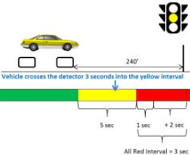Article from: www.thenewspaper.com/news/52/5285.asp
8/29/2017
North Carolina Tests Intersection Crash Reduction Tech
North Carolina officials conclude that dynamic all-red interval system reduces accidents without the need for red light cameras.
 Red light camera vendors insist they have the only technology that can reduce intersection crashes, but the North Carolina Department of Transportation (NCDOT) has been testing its own inexpensive technique that prevents some red light running crashes. The dynamic all red extension (DARE) system uses pavement sensors to detect whether a car has enough time to stop when the light turns yellow. If not, the signal holds all traffic until the car clears the intersection.
Red light camera vendors insist they have the only technology that can reduce intersection crashes, but the North Carolina Department of Transportation (NCDOT) has been testing its own inexpensive technique that prevents some red light running crashes. The dynamic all red extension (DARE) system uses pavement sensors to detect whether a car has enough time to stop when the light turns yellow. If not, the signal holds all traffic until the car clears the intersection.
Ordinarily, traffic in all directions might be held for one or two seconds after the light changes from yellow to red. This is called the "all-red" period. The dynamic system can delay the green light for opposing traffic for another three seconds or more to prevent a crash. After five years of testing, NCDOT researchers shared their findings at the Transportation Research Board's annual meeting earlier this year.
"Since there was not a statistically significant change in red light running at the final compliance study period, while providing increased protection from red light runners, we anticipate a reduction in angle crashes," NCDOT researchers wrote in their formal study of the project. "The DARE system is not going to capture all crashes related to red light running, but it is providing extra protection against angle crashes caused by a specific group of mainline red light running vehicles."
A simple comparison of crash rates before and after the first year of use showed a 26 percent reduction in right-angle crashes without any of the downsides that accompany automated enforcement. The first intersection to receive the dynamic all red setup went from an average of two red light running crashes per year to zero, though other engineering improvements were made during the study period. Eight more locations in rural areas around the state were chosen for more thorough testing.
NCDOT believes that traffic flow can be improved with a dynamic system that extends the all-red time to three seconds as needed, rather than just setting a fixed all red of three seconds. The agency's preliminary evaluation also confirms that drivers did not "adapt" to the longer all-red over the long term.
"There was a chance driver behavior could change if motorists routinely ran the red light and encounter lengthened all-red intervals," the researchers explained. "However, we felt it was more likely for driver behavior to remain relatively unchanged if the red was only extended a handful of times daily in a rural environment and if most drivers did not realize the system was in place."
The researchers found that 82 percent of red light running incidents happened less than a second after the light turned red. This would not cause any accidents because the minimum all-red period is one second. Less than one percent of incidents involved drivers entering the intersection after the light had been red for five seconds or more. This included ambulances and police cars responding to emergencies, or lone cars running the light on deserted streets late at night.
The dynamic all red project targeted the 12 percent of red light running in between these extremes -- cars that enter the intersection between 1 and 5 seconds after the light turns red.
Redflex Traffic Systems offers an all-red extension system called HALO as a red light camera option. The Australian company has not put forward any data on its effectiveness. A copy of the NCDOT report is available in a 1mb PDF file at the source link below.
Source: Pilot Implementation of a Dynamic All-Red Interval (North Carolina Department of Transportation, 2/1/2017)
Permanent Link for this item
Return to Front Page
 Red light camera vendors insist they have the only technology that can reduce intersection crashes, but the North Carolina Department of Transportation (NCDOT) has been testing its own inexpensive technique that prevents some red light running crashes. The dynamic all red extension (DARE) system uses pavement sensors to detect whether a car has enough time to stop when the light turns yellow. If not, the signal holds all traffic until the car clears the intersection.
Red light camera vendors insist they have the only technology that can reduce intersection crashes, but the North Carolina Department of Transportation (NCDOT) has been testing its own inexpensive technique that prevents some red light running crashes. The dynamic all red extension (DARE) system uses pavement sensors to detect whether a car has enough time to stop when the light turns yellow. If not, the signal holds all traffic until the car clears the intersection.